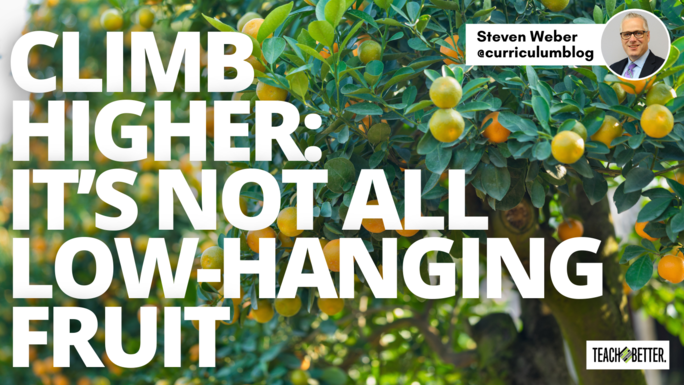TL;DR:
- There are benefits to reaching for the low-hanging fruit: small wins, buy-in, momentum, easier to check off the list, requires fewer meetings and communication, and there is less risk involved.
- We cannot afford to pick low-hanging fruit for a prolonged time.
It’s the second semester and summer break will be here before we know it. Teacher teams and school administrators may have started the school year with ambitious goals. In August, this was going to be the year of transformation and change. However, as we reflect on the first semester, we may have picked all of the low-hanging fruit.
Benefits to Low Hanging Fruit
There are several benefits to reaching for the low-hanging fruit, including:
- Small wins
- Buy-in
- Momentum
- Easier to check off the list
- Requires fewer meetings and communication
- Less risk involved
School leaders should reach for the low-hanging fruit because some of the smaller tasks are attainable.
We cannot afford to always pick the low-hanging fruit.
The struggle for some educators is real. Each year, the school’s leadership team established Wildly Important Goals (WIGs) or a School Improvement Plan. Due to the changes in education, state mandates, school board policies, district initiatives, snow days, or a lack of focus, school leaders reach the second semester and realize time is running out. A high school student who entered ninth grade in 2014 will be graduating this spring. School leaders cannot afford to spend four years picking the low-hanging fruit. An entire cohort of students will graduate before change takes place.
If your school staff is maintaining the status quo or has not reached for a higher branch on the tree, it may be time to get a ladder and reach higher. Click To Tweet
5 Questions to Ask About Fruit and the Top of the Tree:
- What are we committed to accomplishing this school year?
- What’s so wildly important that we cannot afford to address this semester?
- What is one change that would improve student understanding?
- What are we doing to eliminate existing achievement gaps?
- Does our calendar reflect our priorities? How are we spending our time?
“Change may be the ultimate test of a leader — no business survives over the long term if it can’t reinvent itself” (Kotter, 2012). If your school staff is maintaining the status quo or has not reached for a higher branch on the tree, it may be time to get a ladder and reach higher. The hornbook was a great instructional tool at one point in K-12 education. The hornbook was replaced by textbooks. Several schools have transitioned from textbooks to Chromebooks or other devices.
A transformation from hard copy assignments to digital assignments does not immediately shift the opportunity to learn and the quality of the educational experience. Shifts in education require more than attending a conference, purchasing a new product, or writing a school improvement goal. School staff needs to identify the immediate needs. The intent of this article is not to suggest that educators avoid reaching for the low-hanging fruit.
[scroll down to keep reading]
“We must ask, ‘What kind of future are we trying to create?’ Design of that will take divergent & convergent thinking” (Culberhouse, 2018). Where do you want to be by the end of the school year? What kind of foundation are you building for the upcoming school year?
“Beware the easiest goals. While the low-hanging fruit may be tempting, the true rewards often come from climbing higher and stretching for the real treasure in the higher branches” (Reh, 2017).
About Steven Weber
Dr. Steven Weber is the Associate Superintendent for Teaching and Learning with Fayetteville Public Schools (AR). His areas of research include curriculum design, formative assessment, professional learning, and school leadership.



